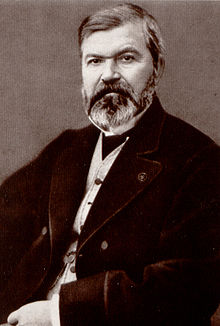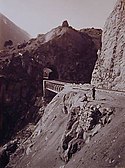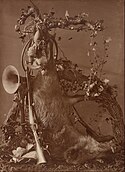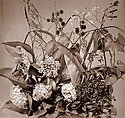Adolphe Braun


Adolphe Braun (* 13. Mai 1812 in Besançon; † 1877 in Dornach) war ein französischer Textildesigner und Fotograf.
Leben und Werk
Zunächst war Adolphe Braun Zeichner und Designer von Stoffmustern in einer Kattundruckerei in Mülhausen (Elsass). 1847 wechselte er zur Fotografie und 1850 eröffnete er in Dornach (1913 eingemeindet zu Mülhausen) ein eigenes Atelier und ab 1868 auch in Paris.
Auf der Weltausstellung in Paris im Jahr 1855 hatte er eine Serie von Blumenstillleben präsentiert, die Beachtung fand und seinen Namen in der Kunstwelt bekannt machte. Dies gilt heute als sein Durchbruch in der Fotografie.
Angesichts der enormen Popularität und Marktgängigkeit der Stereoskopie wandte sich im Jahr 1857 auch Adolphe Braun der Stereofotografie zu. Nur die ersten Stereo-Fotos nahm Braun noch selbst auf, später beschäftigte er sich vorrangig mit der Organisation und dem Vertrieb der Stereoskopien, die seine Operateure in vielen Ländern Europas aufnahmen. Brauns Sortiment umfasst schon bald fast 6.000 Aufnahmen. Braun produzierte in den 1860er Jahren neben Papier-Stereoskopien auch Stereoglasdiapositive.[1]
Brauns Hauptinteresse lag ab den frühen 1860er Jahren zunächst in der Herstellung von topografischen Ansichten von Europa. Später wandte er sich auch der Reproduktion von Kunstwerken wie Gemälden, Zeichnungen, Lithografien, Radierungen und Skulpturen zu. Gefördert von König Ludwig II. von Bayern entstanden über 30.000 Aufnahmen berühmter Gemälde, mit denen Adolphe Braun weltweite Bekanntheit erlangte. Um die benötigten hohen Stückzahlen herzustellen, benutzte er in erster Linie das Kohledruckverfahren.
1869 wurde Adolphe Braun eingeladen, die Eröffnung des Suezkanals in Ägypten zu fotografieren. Aus diesem Anlass fertigte er auch viele der damals sehr beliebten Ansichten einer klischeehaften Vorstellung vom alten Ägypten an mit Palmenwäldern, Kamelen, Pyramiden oder der Sphinx von Gizeh. Weitere Schwerpunkte seines umfangreichen Werkes bilden die Landschaftsfotografie mit großformatigen Panorama-Ansichten, darunter häufig die Alpen, Jagdstillleben, Tierporträts oder die Darstellungen junger Frauen in verschiedenen französischen Trachten.
Auf den fotografischen Ausstellungen erhielt er Auszeichnungen und Medaillen. Daneben hatte er einen landwirtschaftlichen Betrieb mit achtzig Kühen und zehn Pferden.
Während des Deutsch-Französischen Krieges (1870–1871) fotografierte Adolphe Braun zahlreiche Zerstörungen, vor allem in Paris und Belfort oder an Brücken. Nicht nur dokumentierte er damit Kriegsschäden, Bilder von Ruinen waren auch kommerziell rentabel. Später dokumentierte Adolphe Braun den Bau der Gotthardbahn und des Gotthard-Scheiteltunnels, die beide erst fünf Jahre nach seinem Tod fertiggestellt und in Betrieb genommen wurden.
1885 wurde Adolphe Braun mit seinem Unternehmen Ad. Braun et Co. zum offiziellen Fotografen des Louvre erklärt.
Nach seinem Tod wurde seine Arbeit von seinem Sohn Gaston Braun fortgesetzt. Der Unternehmensname änderte sich 1889 in Braun, Clément et Cie und 1910 in Braun et Cie.[2][3]
Ausstellungen
Das Stadtmuseum München und das Musée Unterlinden Colmar zeigten 2017 und 2018 eine umfangreiche Werkschau, die erstmals alle Tätigkeitsfelder Adolphe Brauns anhand von rund 400 Originalaufnahmen vorstellten.[3][4]
- Adolphe Braun:
Stillleben einer Jagdszene, 1867 - Adolphe Braun:
Pont des chemins de fer, Argenteuil, 1871 - Adolphe Braun:
Pont de Champigny-sur-Marne, 1871 - Adolphe Braun:
Asnières, Chemin de fer, 1871 - Adolphe Braun:
Gotthardbahn Luftlokomotive (Ausschnitt).[5] - Adolphe Braun:
Gotthardbahn Tunneleingang in Airolo (Ausschnitt).[5] - Adolphe Braun:
Gotthardbahn Untere Tessinbrücke mit Giornico (Ausschnitt).[5] - Adolphe Braun:
Gotthardbahn Strahllochbrücke (Ausschnitt), ca. 1875.[5]
Literatur
- Ausstellungskatalog: Ulrich Pohlmann, Paul Mellenthin (Hrsg.), in Zusammenarbeit mit Franziska Kunze: Adolphe Braun. Ein europäisches Photographie-Unternehmen und die Bildkünste im 19. Jahrhundert. Mit Texten von Jan von Brevern, Aziza Gril-Mariotte, Christian Kempf, Dorothea Peters, Marie Robert, Bernd Stiegler und den Herausgebern. Schirmer/Mosel, München 2017. ISBN 978-3-8296-0823-7.
- Michel Frizot (Hrsg.): Neue Geschichte der Fotografie. Könemann 2001. ISBN 3-8290-1327-2.
- Ute Eskildsen (Hrsg.): Die Brüder Bisson. Aufstieg und Fall eines Fotografenunternehmens im 19. Jahrhundert. Verlag der Kunst 1999. ISBN 90-5705-123-0.
- Helmut Gernsheim: Geschichte der Photographie – Die ersten Hundert Jahre. Propyläen Verlag, Wien 1983. ISBN 3-549-05213-8.
- N.N.: Adolphe Braun in Dornach. In: Hermann Vogel (Hrsg.): Photographische Mitteilungen, 4. Jg., Louis Gerschel Verlagsbuchhandlung, Berlin 1868, S. 99 ff. und 145 ff., online.
Weblinks
- Publikationen von und über Adolphe Braun im Katalog Helveticat der Schweizerischen Nationalbibliothek
- Sammlung Adolphe Braun in der Archivdatenbank HelveticArchives der Schweizerischen Nationalbibliothek
- Adolphe Braun, Photo-Unternehmer: «Gutenberg der Kunst»
Einzelnachweise
- ↑ Ulrich Pohlmann, „VI. Vue stéréoscopiques – Stereoaufnahmen“, S. 169–171, S. 169, in: Ulrich Pohlmann, Paul Mellenthin (Hrsg.), in Zusammenarbeit mit Franziska Kunze, „Adolphe Braun. Ein europäisches Photographie-Unternehmen und die Bildkünste im 19. Jahrhundert“. Ausstellungskatalog; mit Texten von Jan von Brevern, Aziza Gril-Mariotte, Christian Kempf, Dorothea Peters, Marie Robert, Bernd Stiegler und den Herausgebern. Verlag Schirmer/Mosel, München 2017
- ↑ John Hannavy: Encyclopedia of nineteenth-century photography, Vol. 1, Routledge, New York/London 2008, S. 205.
- ↑ a b Adolphe Braun. Ein europäisches Photographie-Unternehmen und die Bildkünste im 19. Jahrhundert. Stadtmuseum München, archiviert vom (nicht mehr online verfügbar) am 7. November 2017; abgerufen am 1. November 2017.
- ↑ Kein Weg zu weit in FAZ vom 16. November 2017, Seite R6
- ↑ a b c d Adolphe Braun: Photographische Ansichten der Gotthardbahn, Dornach im Elsass, ca. 1875.
| Personendaten | |
|---|---|
| NAME | Braun, Adolphe |
| KURZBESCHREIBUNG | französischer Textildesigner und Fotograf |
| GEBURTSDATUM | 13. Mai 1812 |
| GEBURTSORT | Besançon, Frankreich |
| STERBEDATUM | 1877 |
| STERBEORT | Dornach |
Auf dieser Seite verwendete Medien
The image shows a pneumatic locomotive used during the construction of the Gotthard Rail Tunnel behind an archway or short tunnel of just a few meters. The original caption of the image translates to "Tunnel Entrance in Airolo", which probably indicates the approximate location of the shown arch, which is not the southern portal to the Gotthard Rail Tunnel itself.
The shown pneumatic locomotive stored energy in the form of compressed air in the large pressure container up front. The released expanding air was used to operate the motor of the locomotive. Steam driven compressors were readily available at the time of the construction (1872-1880) and for example in use to drive pneumatic drills. Most probably these compressors were also used to load the pressure containers outside the tunnel. (The first DC motors were just being developed and the AC motor was patented by Tesla only in 1888.) In contrast to steam engines the pneumatic engines did not require additional ventilation of the tunnel during its construction. Even using pneumatic technology the tunnels were poorly ventilated adding to the poor work conditions.
Adolphe Braun (1812-1877), Photographer
The image shows the original Strahlloch Bridge (or Viaduct) and the directly adjoining Strahlloch Tunnel at km 64.2 of the Gotthardbahn. Strahlloch Bridge and Tunnel are part of the double loop in Wassen on the northern access ramp to the Gotthard Rail Tunnel. Going south on the Gotthardbahn and up the northern ramp, having passed Wassen Station you pass from the Strahlloch Tunnel onto the Strahlloch Bridge before entering the second turn tunnel of the double loop the Leggistein Turn Tunnel. With the Leggistein Tunnel in his back to the right the photographer was looking in the opposite direction across the Strahlloch Bridge onto the northern portal of the Strahlloch Tunnel.
The picture was taken before 1878 with commercial operation of this central part of the Gotthardbahn only starting in June of 1882 and the ramps and the Gotthardtunnel still under construction.
The bridge shows the single beam truss construction that was typical for the majority of the original bridges on this line, and which later had to be fortified with supporting fishbellies or arches with increasing traffic loads until they eventually had to be replaced with reinforced concrete or other bridges.
The image shows a pneumatic locomotive used in the construction of the Gotthard Rail Tunnel and other tunnels of the Gotthardbahn and an attached carriage with an additional pressure container. Energy was stored in the form of compressed air in the two pressure containers of the locomotive and the trailer. The released expanding air was used to operate the motor of the locomotive. Steam driven compressors were readily available and for example in use to drive pneumatic drills. Most probably these compressors were also used to load the pressure containers outside the tunnel. (The first DC motors were just being developed and the AC motor was patented by Tesla only in 1888.) In contrast to steam engines the pneumatic engines did not require additional ventilation of the tunnel during its construction. Even using pneumatic technology the tunnels were poorly ventilated during construction resulting in poor work conditions.
The original is a photograph by Adolphe Braun published in a probably small edition book "Photographische Ansichten der Gotthardbahn" (58 photographs (28x23 cm2) mounted on each single page plus one two-page panorama), published around 1875 or shortly thereafter. The exact date of publication is not clear. The original in the book was photographed at an angle and the resulting image was clipped to show central detail and to reestablish a rectangular frame. The resulting image is somewhat distorted with respect to the original photograph by Adolphe Braun and very much reduced in resolution. The German caption of the photo in the book reads "Luftlokomotive" (literally: Air-Locomotive).
Pflanzenstudie
The image shows the original Lower Ticino Bridge on the southern access ramp to the Gotthard Rail Tunnel with Giornico in the background and a steam locomotive with two flatcars passing the bridge. The picture was taken before 1878 with commercial operation of this central part of the Gotthardbahn only starting in June of 1882 and the ramps and the Gotthardtunnel still under construction.
The bridge shows the single beam truss construction that was typical for the majority of the original bridges on this line, and which with increasing traffic loads had to be fortified with supporting fishbellies or arches until they eventually had to be replaced with reinforced concrete or other bridges.
The routes from Giornico to the neighboring stations of Lavorgo and Bodio exhibit the steepest inclines of the Gotthardbahn of up to 27‰.




![Adolphe Braun: Gotthardbahn Luftlokomotive (Ausschnitt).[5]](http://upload.wikimedia.org/wikipedia/commons/thumb/0/07/CompressedAirLocomotive_Section1_AdolpheBraun1811to1877.jpg/120px-CompressedAirLocomotive_Section1_AdolpheBraun1811to1877.jpg)
![Adolphe Braun: Gotthardbahn Tunneleingang in Airolo (Ausschnitt).[5]](http://upload.wikimedia.org/wikipedia/commons/thumb/c/c5/CompressedAirLocomotiveNearTunnelEntranceInAirolo_Section1_AdolpheBraun1811to1877.jpg/114px-CompressedAirLocomotiveNearTunnelEntranceInAirolo_Section1_AdolpheBraun1811to1877.jpg)
![Adolphe Braun: Gotthardbahn Untere Tessinbrücke mit Giornico (Ausschnitt).[5]](http://upload.wikimedia.org/wikipedia/commons/thumb/d/d8/LowerTicinoBridgeWithGiornico_Section1_AdolpheBraun1811to1877.jpg/120px-LowerTicinoBridgeWithGiornico_Section1_AdolpheBraun1811to1877.jpg)
![Adolphe Braun: Gotthardbahn Strahllochbrücke (Ausschnitt), ca. 1875.[5]](http://upload.wikimedia.org/wikipedia/commons/thumb/e/e3/StrahllochBridgeAndTunnelOfGotthardbahn_Section1_AdolpheBraun1811to1877.jpg/89px-StrahllochBridgeAndTunnelOfGotthardbahn_Section1_AdolpheBraun1811to1877.jpg)









